Today, we’re going to make one of Italy’s most beloved sauces, homemade basil pesto. A staple in Italian cuisine, pesto is a sauce that originated in the picturesque coastal region of Liguria, Italy, where it is referred to as “Pesto alla Genovese“. While highly celebrated, pesto is not confined to one standard recipe. There are countless variations, each bringing its own unique blend of flavors to the table.
The most famous pesto recipe is the classic basil pesto variant, but there’s also a tangy sun-dried tomato version, and each is a testament to the incredible flavors that simple, high-quality ingredients can produce.
Let’s look at how to make this timeless Italian classic at home: Basil Pesto
Looking for something a little different?
Check out this Homemade Sun-Dried Tomato Pesto Recipe here.
Table of contents:
- Basil Pesto: A Classic Italian Recipe
- Dietary Suitability for Basil Pesto
- Serving Suggestions for Pesto
- Do I need to blanch the basil before making pesto?
- Basil Pesto FAQs
- Nutrition Facts Basil Pesto
Basil Pesto: A Classic Italian Recipe
Traditional pesto, also known as “Pesto alla Genovese” is a bright, flavorful blend of fresh basil leaves, pine nuts, garlic, Parmesan cheese, salt, and extra-virgin olive oil. Each ingredient plays a critical role in the final product’s taste and texture.
- Basil: The foundation of the recipe, it contributes its vibrant green hue and characteristic anise and clove notes. Fresh basil is packed with Vitamin K and antioxidants.
- Pine nuts: These contribute a buttery texture and sweet, nutty flavor. They’re a great source of monounsaturated fats and Vitamin E.
- Garlic: A single clove can infuse the pesto with an intense, pungent flavor. Garlic has numerous health benefits, including antimicrobial properties and cardiovascular health support.
- Parmesan Cheese: Its sharp, umami flavor adds depth to the pesto. Cheese is a good source of protein and calcium.
- Extra-virgin olive oil: This helps emulsify the ingredients into a smooth paste and adds a fruity richness. Olive oil is praised for its heart-healthy monounsaturated fats.
- Salt: This lifts all the other flavors and makes the pesto come alive.
Due to the Parmesan, this isn’t suitable for vegetarians or vegans. Vegetarians can substitute it for another Italian-style hard cheese, just check the labels to make sure there’s no animal rennet used or that it’s marked vegetarian. A vegan alternative can be made by substituting the parmesan with nutritional yeast (you’ll only need about half the amount).
How to Make Basil Pesto
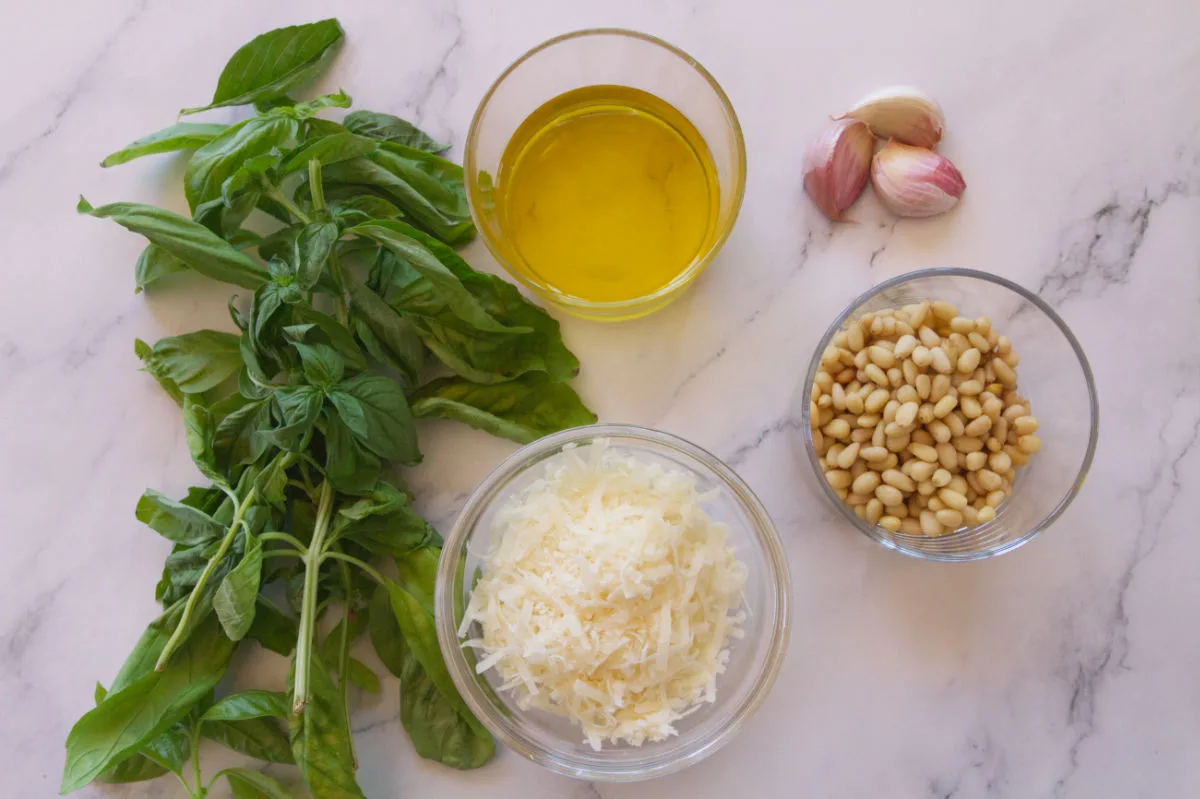
Equipment
- Food processor
- Box Grater
- Paper towel
- Cooking pot with lid
- Large Glass bowl
- Scissors (optional)
Ingredients
- 2 cups fresh basil leaves
- 1/3 cup Pine Nuts
- 3 cloves garlic
- 1/2 cup grated Parmesan cheese
- 1/2 cup Extra Virgin Olive Oil (Italian)
- Salt to taste
Instructions
Step 1 – Blanch basil leaves
- Bring a large pot of water to a boil. While waiting for the water to boil, fill a large bowl with cold water and ice cubes. Set aside.
- Add a pinch of salt and the basil leaves to the boiling water and blanch for 15 seconds maximum. Immediately remove the leaves from the boiling water and place in the ice water bath.
- Once cooled, give the leaves a little shake to drain off any excess water.
- Squeeze the leaves to remove all excess water and lay them on a paper towel.
Step 2 – Prepare pesto
- Use sharp scissors to cut the leaves into 1-inch (2cm) pieces. Place basil leaves, pine nuts, and peeled garlic cloves in the bowl of a food processor.
- Pulse until coarsely chopped.
- Add Parmesan cheese and pulse again until mixed.
- Slowly drizzle in the olive oil while the food processor is on until the mixture is smooth.
- Season with salt to taste.
- Your basil pesto is ready to serve. If not using immediately, store it in an airtight container in the refrigerator.

Dietary Suitability for Basil Pesto
Pesto is not suitable for vegetarians or vegans without some moderation (just swap out the Parmesan). Vegetarians can substitute it for another Italian hard cheese and vegans can use nutritional yeast instead.
- Suitable for gluten-free diets: The traditional recipes for both Basil Pesto and Sun-Dried Tomato Pesto are gluten-free, so they can be enjoyed by individuals with celiac disease or gluten sensitivities.
- Not Suitable for Dairy-Free diets: The Parmesan cheese makes these unsuitable for individuals following a dairy-free or lactose-free diet. Sun-Dried Tomato Pesto can also be unsuitable if Parmesan is included. You can use nutritional yeast instead of cheese, just halve the amount and taste from there.
- Suitable for the Mediterranean diet: Both pesto variations, especially when made with high-quality olive oil and fresh ingredients, align with the principles of the Mediterranean diet.
Serving Suggestions for Pesto
Pesto is a versatile and flavorful sauce that can be used in a variety of dishes. Here are some serving suggestions for pesto:
- Pasta: The most common use for pesto is as a pasta sauce. Simply toss cooked pasta (such as spaghetti, linguine, or penne) with a generous amount of pesto. You can also add some sautéed vegetables, cherry tomatoes, or grilled chicken for extra flavor and texture.
- Sandwiches and Wraps: Spread pesto on bread or tortillas before adding your favorite fillings. It works well with grilled vegetables, deli meats, cheeses, and even tofu or tempeh for a vegetarian option.
- Salads: Use pesto as a dressing for salads. Mix it with olive oil and a touch of lemon juice, then drizzle it over your greens. It’s especially great with salads containing tomatoes, mozzarella, and basil (Caprese salad).
- Grilled Meats and Seafood: Pesto can serve as a marinade or topping for grilled meats like chicken, pork, or beef, as well as seafood like salmon, shrimp, or scallops. Spread a thin layer of pesto on the meat or fish before grilling, or spoon some over the cooked dish before serving.
- Vegetables: Roasted or steamed vegetables are enhanced by a dollop of pesto. Drizzle the sauce over vegetables like roasted potatoes, broccoli, asparagus, or zucchini for an extra burst of flavor.
- Pizza: Use pesto as a base sauce for homemade pizzas instead of the traditional tomato sauce. Top with your favorite cheeses, vegetables, and meats for a unique twist.
- Dips and Spreads: Mix pesto with cream cheese, yogurt, or sour cream to create flavorful dips for crackers, breadsticks, or fresh vegetables.
- Rice and Grains: Stir pesto into cooked rice, quinoa, couscous, or other grains for a quick and tasty side dish.
- Eggs: Swirl pesto into scrambled eggs, omelets, or frittatas for a burst of color and flavor.
- Bread and Crostini: Spread pesto on toasted baguette slices or crostini as an appetizer or snack.
- Soup: Add a spoonful of pesto to soups, such as tomato soup, minestrone, or vegetable soups, to elevate the flavor.
- Stuffed Chicken or Fish: Create a pocket in chicken breasts or fish fillets and stuff them with a mixture of pesto and cheese before baking or grilling.
Basil Pesto is strong in flavor, so a little goes a long way. This recipe makes enough for a dip or pasta sauce for 4 people.
Do I need to blanch the basil before making pesto?
Short answer, Yes. If you want to retain the bright green color of the basil leaves, you’ll need to blanch your basil before adding it to the food processor.
Another tip for retaining the brightest pesto color possible is to use freshly picked basil. Adding green peas to your basil pesto also helps give it that bright green color.
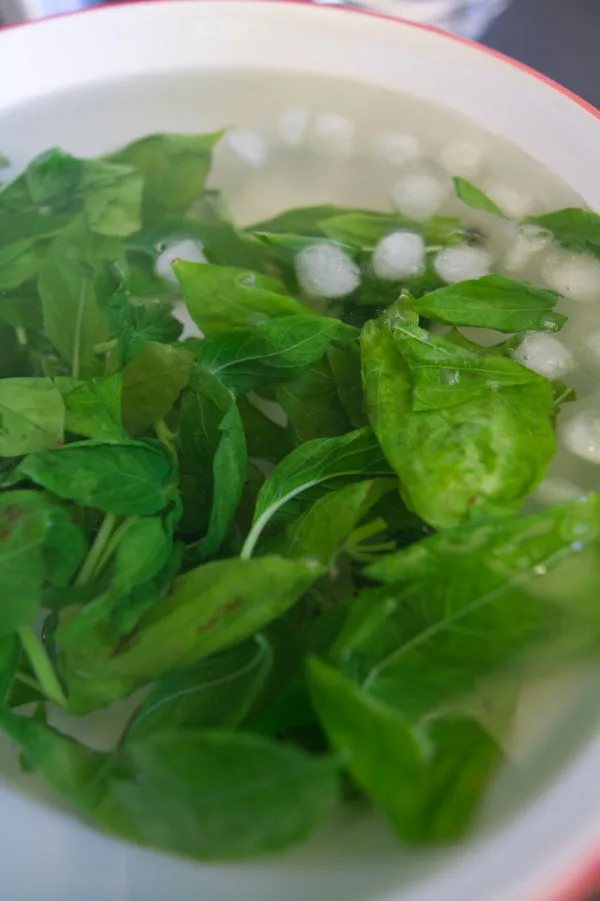
Basil Pesto FAQs
How long does basil pesto take to make?
- Prep time: 15 minutes
- Cook time: None
- Total time: 15 minutes
How long will basil pesto keep in the fridge?
Homemade basil will keep for 2-3 days when refrigerated in an airtight container.
What is pesto and how is it used in cuisine?
Pesto is a flavorful sauce that originates from Genoa, the capital of Liguria in Italy. A common way to enjoy pesto is with pasta and fresh tomatoes. However, it can also be paired with breadsticks or spread over a sandwich. Pesto is versatile and can also be used as a dip, pizza sauce, spread, salad dressing, and more.
Are there vegan versions of pesto available?
Yes, while traditional pesto often contains Parmesan cheese, there are increasing numbers of vegan pesto brands appearing in the market. However, finding vegan pesto might be challenging in some stores. Luckily, you can make your own pesto at home and substitute the Parmesan for a vegan cheese or nutritional yeast.
What are the nutritional aspects of pesto?
Pesto is generally rich in healthy fats. For every tablespoon (16g) of pesto, it provides around 92 calories, 9.5g of fat, 158mg of sodium, 0.9g of carbohydrates, 0.2g of fiber, 0.11g of sugars, and 1.4g of protein. The fats in pesto come primarily from olive oil, cheese, and nuts.
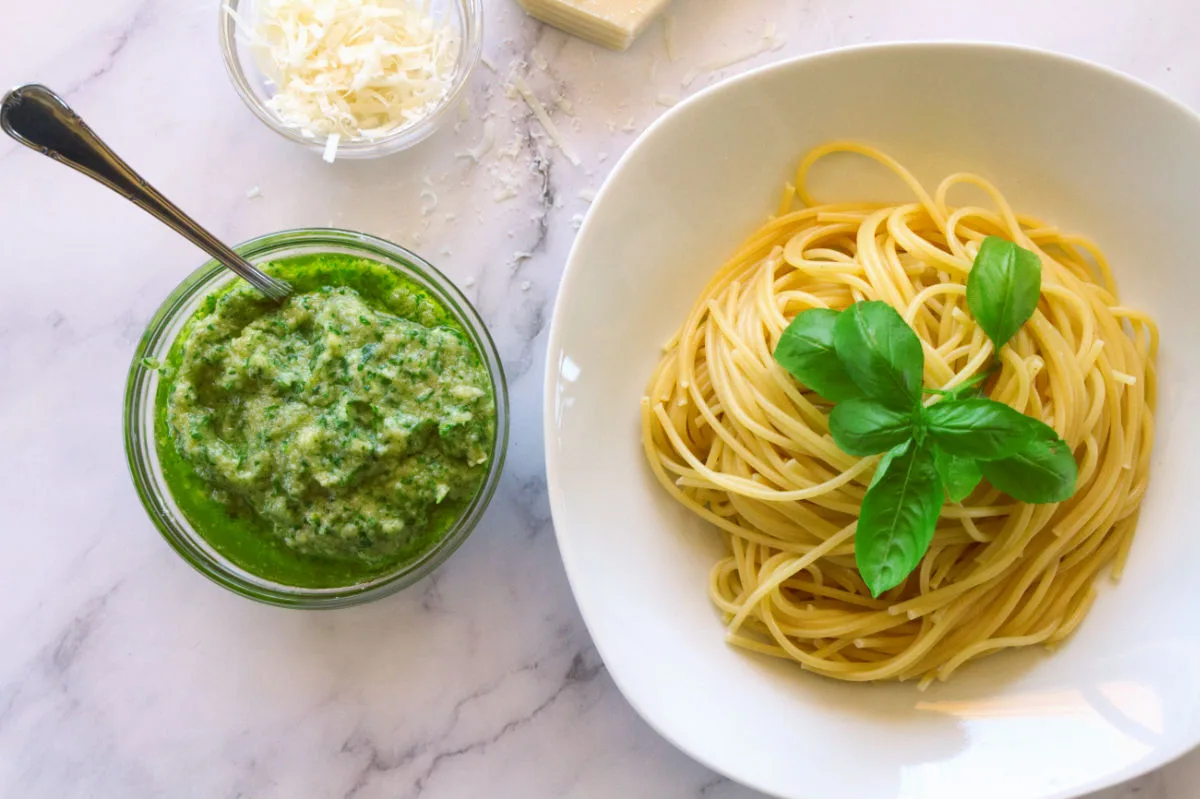
Nutrition Facts Basil Pesto
| Servings: 4 | |
| Amount per serving | |
| Calories | 343 |
| % Daily Value* | |
| Total Fat 36g | 46% |
| Saturated Fat 6.2g | 31% |
| Cholesterol 10mg | 3% |
| Sodium 170mg | 7% |
| Total Carbohydrate 3g | 1% |
| Dietary Fiber 0.7g | 2% |
| Total Sugars 0.5g | |
| Protein 6.6g | |
| Vitamin D 0mcg | 0% |
| Calcium 152mg | 12% |
| Iron 1mg | 6% |
| Potassium 112mg | 2% |
| *The % Daily Value (DV) tells you how much a nutrient in a food serving contributes to a daily diet. 2,000 calorie a day is used for general nutrition advice. | |
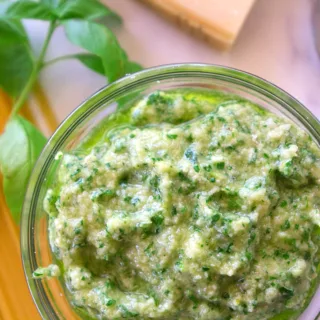
Basil Pesto
Equipment
- Food processor
- Box/cheese grater
Ingredients
- 2 cups fresh basil leaves
- 1/3 cup pine nuts
- 3 cloves garlic
- 1/2 cup grated Parmesan cheese
- 1/2 cup extra-virgin olive oil
- Salt to taste
Instructions
- Place basil leaves, pine nuts, and peeled garlic cloves in the bowl of a food processor.2 cups fresh basil leaves, 1/3 cup pine nuts, 3 cloves garlic
- Pulse until coarsely chopped.
- Add Parmesan cheese and pulse again until mixed.1/2 cup grated Parmesan cheese
- Slowly drizzle in the olive oil while the food processor is on until the mixture is smooth. Season with salt to taste.1/2 cup extra-virgin olive oil
- Your basil pesto is ready to serve. If not using immediately, store it in an airtight container in the refrigerator.
Video
Notes
Nutrition Facts Basil Pesto
| Servings: 4 | |
| Amount per serving | |
| Calories | 343 |
| % Daily Value* | |
| Total Fat 36g | 46% |
| Saturated Fat 6.2g | 31% |
| Cholesterol 10mg | 3% |
| Sodium 170mg | 7% |
| Total Carbohydrate 3g | 1% |
| Dietary Fiber 0.7g | 2% |
| Total Sugars 0.5g | |
| Protein 6.6g | |
| Vitamin D 0mcg | 0% |
| Calcium 152mg | 12% |
| Iron 1mg | 6% |
| Potassium 112mg | 2% |
| *The % Daily Value (DV) tells you how much a nutrient in a food serving contributes to a daily diet. 2,000 calorie a day is used for general nutrition advice. | |
More Delicious Italian Recipes:
- Bolognese Sauce (Ragu alla Bolognese)
- Tagliatelle Pasta with Sun-Dried Tomatoes (Vegetarian)
- Spaghetti with Anchovies and Capers
- Chicken Tagliatelle Pasta with Sun-Dried Tomatoes
- Gorgonzola Pizza with Pear and Red Onion

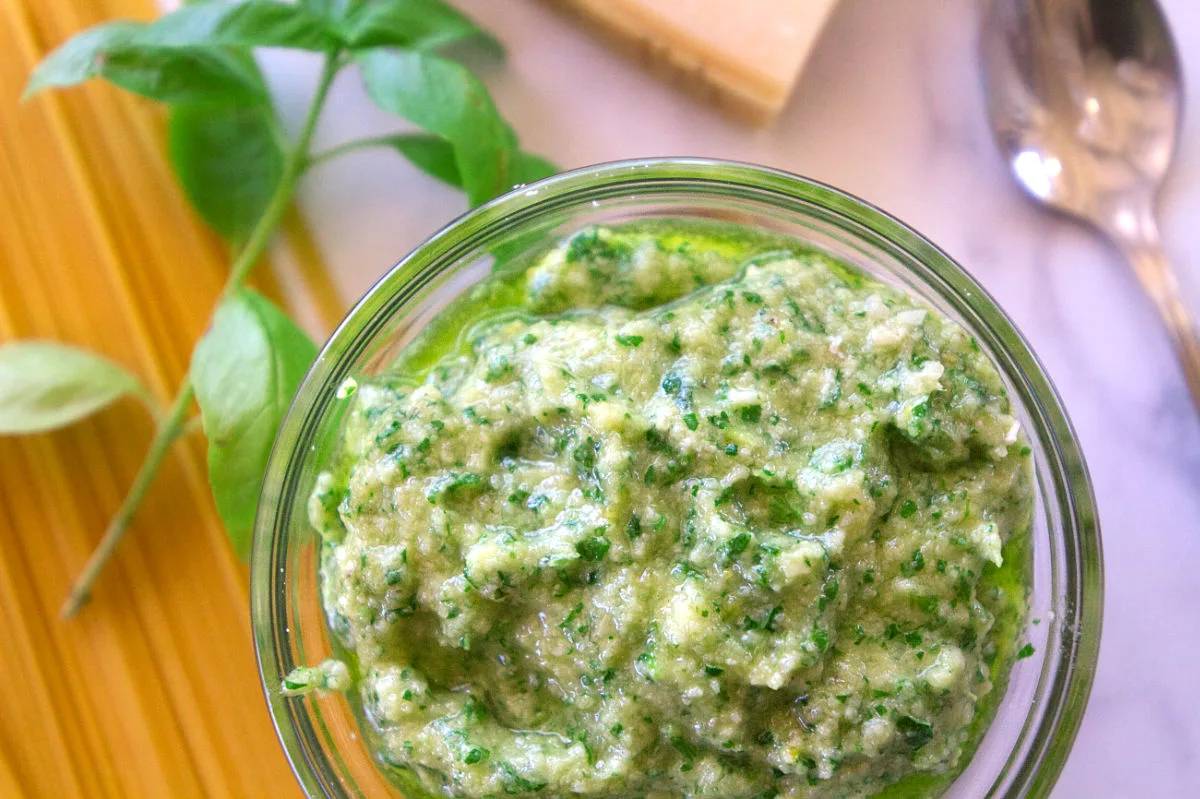



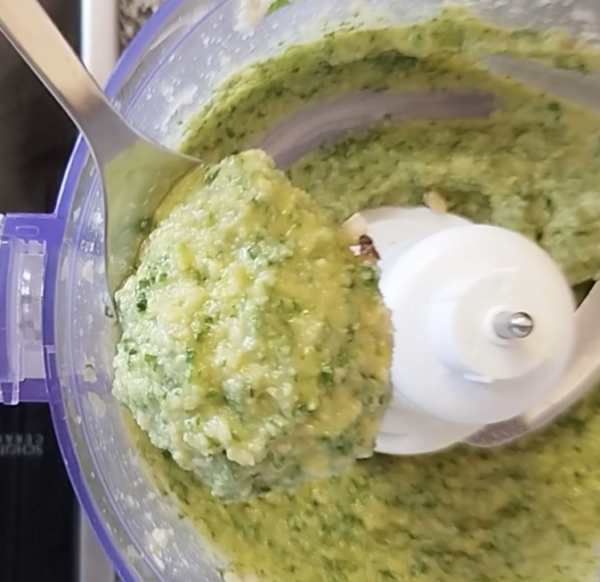
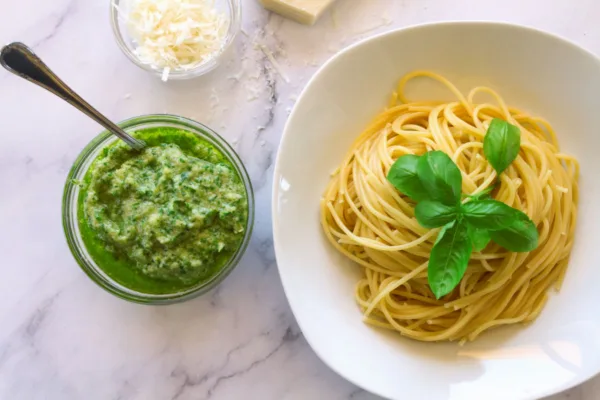
Leave a Reply